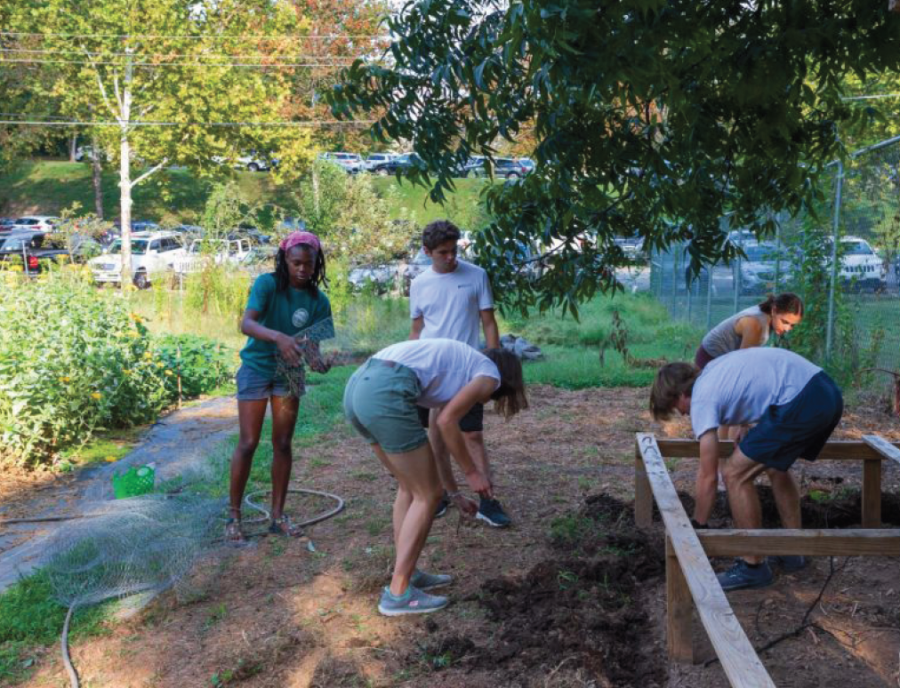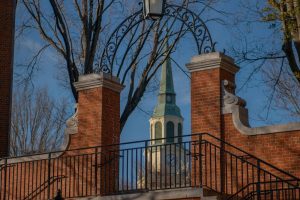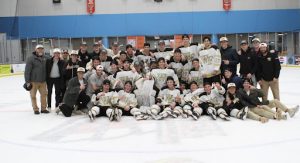Finding community at the edge of the forest
The Campus Garden offers a space for environmentally-minded students to connect
Students gather weekly at Campus Garden to volunteer.
April 6, 2022
When driving down Polo Road, if you turn your head for just a second, you might miss a campus space.
However, next to the sophomore parking lot, tucked behind a shed with a red pickup truck parked out front, lies an integral part of campus’s sustainable community: the Campus Garden.
What was once an empty greenspace is now an oasis for sandal-wearing, eco-kids and for anyone interested in all things “susty”; a relatively versatile term for those in the know, which encapsulates the small, but mighty subculture of environmentalism and sustainable living within the Wake Forest community.
“The garden is the door to access everything environmental at Wake,” sophomore Ty Zanders, one of the three student Campus Garden interns said. “Though it’s not the most impactful project in terms of reducing carbon emissions, it’s a visible space on campus for sustainability and proof that the school cares about this movement.”
Since 2007, Wake Forest has proven its commitment to more sustainable practices through the Sustainability Strategic Plan. This plan entails several steps towards climate neutrality, including a 47% decrease in carbon emission reduction, much of which is attributed to university building renovations improving efficiency, according to the Office of Sustainability. However, a helpful way to impact climate change is through individual action. According to Project Drawdown data, one of the best strategies to fight climate change is reducing food waste.
Discarded food ultimately wastes all the energy and resources expended to produce the food, worsening the modern agriculture industry’s greenhouse gas footprint, which accounts for a quarter of global emissions, according to Drawdown.
This is largely due to the energy-intensive global production and transportation processes embedded within today’s industrial agricultural system, according to the U.S. Department of Agriculture.
The Campus Garden’s “closed-loop food chain” is an example of a more sustainable, regional agricultural system and produces much less of a greenhouse gas footprint, Nathan Peifer, the garden’s manager says.
The garden acts not only as an example of carbon-neutral agricultural practices but as a community center and primary teaching tool, says Peifer.
According to Peifer, Campus Garden provides students with hands-on education surrounding sustainable food sourcing in the absence of an agriculture program on campus. Each semester, the garden works with 12-18 classes, as well as different student groups, clubs and individual volunteers.
Campus Garden is primarily supported by the Campus Garden interns, the Cultivation Leadership Team (CLT) and Garden Ambassador Program, Peifer said. The pandemic sparked a larger influx of volunteers, which has allowed these teams to enact new engagement opportunities for the general student body.
On weekdays from March 20 until the end of finals week, the CLT team is hosting hour-long “Cultivate & Connect” volunteer sessions, open to the entire campus.
Peifer believes the pandemic response and new opportunities have transformed the garden into a space that benefits not only the environment but also one’s physical, mental and community wellbeing.
“It’s not just about agriculture production,” Peifer said. “It’s about relaxation and meeting new people.”
However, you don’t need to be fully plugged into nature or agriculture to find a home within the garden.
“We’re often a catch all for people who aren’t caught up in the mainstream community,” Zanders said. “A lot of us were once in that spot, where we didn’t always feel welcome at Wake Forest. Here, we’re all just trying to support and spread that susty love.”
Garden volunteers sophomore Ashlyn Segler and senior Sanford Miller both found community by getting involved at the garden.
“A lot of people find their circle in the garden, or at least I know I did,” Miller said. “It’s a really chill environment.”
“There are so many different events and programs through the Office of Sustainability,” Segler said. “It’s really helped me find people who are passionate about the same things as me.”
Zanders described the Campus Garden as a doorway to the diverse ‘susty’ campus community.
“The garden is how a lot of students first find the susty community, which is important,” Zanders said. “From there, people can connect you to other opportunities you’re passionate about.”














